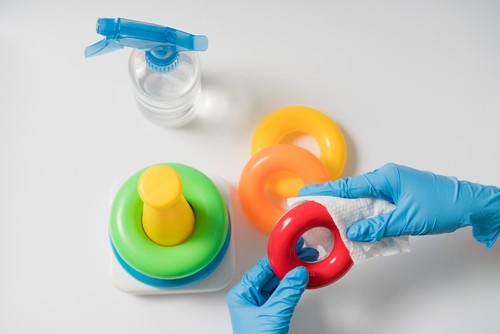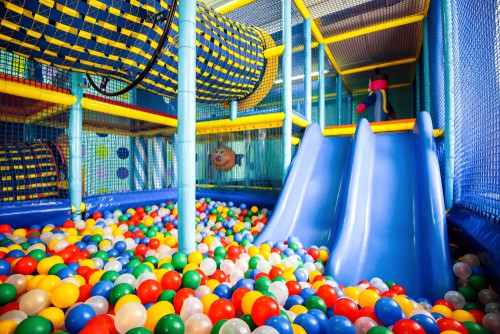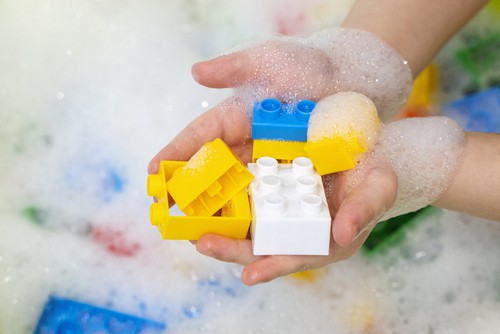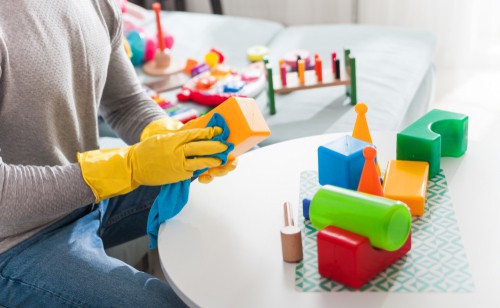Cleaning Your Child’s Toys – Safety and Hygiene

Cleaning Your Child's Toys - Safety and Hygiene
Cleaning Your Child’s Toys – Safety and Hygiene. Ensuring the cleanliness of your child’s toys is not merely a matter of routine maintenance; it is a paramount concern for safeguarding their health and well-being.
The presence of germs, allergens, and potentially harmful chemicals on toys can pose significant risks to your child, making the regular cleaning of toys a critical aspect of responsible parenting.
This comprehensive guide is dedicated to the principles and practices of cleaning your child’s toys with meticulous attention to safety and hygiene.
By delving into the depths of toy contamination, age-appropriate cleaning strategies, and the judicious selection of cleaning products, you will empower yourself to protect your child’s safety and well-being through the maintenance of clean toys.
Table of Contents
Understanding Toy Contamination
Sources of Toy Contamination
1. Germs and Bacteria
Toys, often cherished companions of children, can unwittingly become breeding grounds for insidious germs and bacteria. This is especially pronounced in cases where toys are frequently shared among children or have been exposed to environments less than sanitary.
2. Allergens
Toys are not immune to accumulating common household allergens such as dust, pet dander, and pollen. These microscopic particles can quietly settle on toys, posing a hidden threat to sensitive children who may suffer allergic reactions upon contact.
3. Chemicals and Toxins
In today’s marketplace, toys may sometimes harbor chemicals and toxins that, if ingested or absorbed through the skin, can be detrimental to a child’s health. This underlines the necessity of regular cleaning and the judicious selection of cleaning products.
Health Risks Associated with Contaminated Toys
Contaminated toys, although seemingly harmless at first glance, can carry profound health risks for your child. These risks span from the development of infections and allergic reactions to the more sinister long-term consequences of chemical exposure, all of which underscore the urgency of diligent toy cleaning.
Age-Appropriate Cleaning Guidelines

Cleaning Toys for Infants
1. Teething Toys
Their regular cleaning regimen should be a top priority when it comes to teething toys, which are particularly prone to drool and mouthing. These toys, integral in soothing teething discomfort, necessitate cleaning practices aligned with the fragility and vulnerability of infants.
2. Plush and Fabric Toys
Plush and fabric toys, often cherished infant comfort objects, can silently accumulate dust and allergens. The delicate nature of these toys requires cleaning techniques that ensure their hygiene without compromising their softness and integrity.
Cleaning Toys for Toddlers
1. Plastic and Rubber Toys
As toddlers begin to explore their world, plastic and rubber toys become their companions of choice. Frequently subjected to rigorous handling, these toys must undergo cleaning procedures tailored to their resilience and the specific contaminants they encounter.
2. Bath Toys
Regularly exposed to water and moisture, bath toys present unique challenges in cleaning and mold prevention. Ensuring these toys remain hygienic and safe for bath time is paramount.
Cleaning Toys for Older Children
1. Board Games and Puzzles
As children grow, they graduate to more complex playthings such as board games and puzzles. Often shared among siblings and friends, these toys call for distinct cleaning methods that preserve their functionality and encourage continued use.
2. Electronic and Battery-Operated Toys
Electronic and battery-operated toys featuring intricate mechanisms and electrical components require specialized care during cleaning to ensure both their longevity and your child’s safety.
Safe Cleaning Products

Child-Friendly Cleaning Solutions
1. Homemade Cleaning Mixtures
Homemade mixtures provide a viable alternative for parents seeking natural and child-friendly cleaning solutions. These concoctions, often composed of readily available household ingredients, effectively maintain toy hygiene while minimizing chemical exposure.
2. Commercial Toy Cleaners
The market offers a range of commercial toy cleaning products designed with child safety in mind. These products, subject to rigorous safety standards, offer convenience and efficacy for busy parents.
Avoiding Harsh Chemicals
A critical consideration in toy cleaning revolves around the avoidance of harsh chemicals. Harsh cleaning agents, while effective against contaminants, may pose risks to children if not used judiciously. Selecting cleaning products with child safety in mind is paramount.
Allergen-Free Cleaning
For children with allergies or sensitivities, allergen-free cleaning practices are essential. Implementing strategies that eliminate allergenic particles from toys ensures a safe and comfortable play environment.
Cleaning Methods

Surface Cleaning
1. Wiping with Disinfectant
Surface cleaning, achieved through the meticulous wiping of toys with child-safe disinfectants, plays a central role in the removal of germs and bacteria. This method targets high-contact areas and frequently handled toys.
2. Cleaning Stuffed Animals
Stuffed animals, beloved companions for many children, require specialized cleaning methods that maintain their softness and comfort while ensuring they remain free from contaminants.
Submersion Cleaning
1. Bath Toy Cleaning
Toys designated for bath time require submersion cleaning techniques to prevent mold growth and maintain their suitability for water play. Proper cleaning ensures bath toys remain both fun and safe.
2. Cleaning Toys in the Dishwasher
Certain toys can be safely cleaned in the dishwasher, provided that specific precautions are observed. Dishwasher cleaning offers convenience and thorough hygiene.
Toy Care Labels and Instructions
1. Following Manufacturer’s Recommendations
Adhering to the cleaning recommendations provided by toy manufacturers is paramount to ensure toy safety and longevity. These guidelines are formulated with both functionality and child safety in mind.
2. Cleaning Battery-Operated Toys Safely
Battery-operated toys require careful handling during cleaning to prevent damage to their electrical components and to safeguard against potential hazards.
Regular Cleaning Schedule
Establishing a Routine
Creating and adhering to a regular toy cleaning routine is fundamental in maintaining a consistently hygienic play environment for your child.
High-Contact and Frequently Used Toys
Toys that receive the most attention and interaction from your child should be prioritized in terms of cleaning frequency. High-contact toys are more likely to harbor contaminants.
Seasonal Toy Cleaning
In addition to routine cleaning, seasonal deep cleaning sessions for toys offer a layer of hygiene. These sessions help to mitigate the accumulation of contaminants over time.
Special Considerations

Allergies and Sensitivities
Children with allergies or sensitivities require special considerations when it comes to toy cleaning. Implementing measures to minimize allergen exposure is essential for their well-being.
Shared Toys in Playgroups or Schools
In scenarios where toys are shared among children in playgroups or school settings, proactive measures should be taken to ensure the cleanliness and safety of these communal playthings.
Handling Toys After Illness
In the wake of illness, cleaning and sanitizing toys to prevent the spread of germs and maintain a safe play environment for your child.
Sanitizing Toys During Pandemics
Cleaning During Disease Outbreaks
During pandemics or disease outbreaks, heightened cleaning measures are necessary to ensure your child’s safety. Vigilant toy cleaning is essential in such circumstances.
Safe Handling of Shared Toys
Adopting safe handling practices becomes imperative when dealing with shared toys during health crises. Preventative measures are essential to mitigate the risk of disease transmission.
Teaching Children Good Hygiene Practices
Teaching your child good hygiene practices, such as handwashing and responsible toy handling, is a crucial step in maintaining a safe play environment, particularly during pandemics.
Storage Solutions
Proper Toy Storage
Effective toy storage solutions are instrumental in preventing contamination between play sessions. Proper organization contributes to both cleanliness and the longevity of toys.
Rotation of Toys
Rotating toys in and out of play allows for a manageable cleaning schedule and keeps toys fresh and engaging for your child.
Toy Storage Containers
Investing in suitable toy storage containers can simplify the organization of toys and enhance their protection from contaminants.
Involving Your Child

Teaching Children About Toy Hygiene
Educating your child about the importance of toy hygiene fosters a sense of responsibility and an understanding of the connection between cleanliness and well-being.
Encouraging Good Cleaning Habits
Encouraging good cleaning habits in your child instills a sense of pride in their environment and fosters a lifelong commitment to hygiene.
Making Cleaning Fun
Transforming the cleaning process into an enjoyable and educational activity can engage your child’s interest and cooperation.
Frequently Asked Questions (FAQs)
How often should I clean my child’s toys?
Determining the ideal cleaning frequency is contingent upon your child’s age and the extent of toy usage. A regular cleaning routine should be established based on these factors.
Can I use regular household cleaners on toys?
The safety of using regular household cleaners on toys depends on the specific cleaner and the toy material. It is essential to consider child-friendly alternatives when necessary.
Are there specific cleaning methods for different types of toys?
Different types of toys require tailored cleaning methods. Understanding these methods ensures effective and safe toy cleaning.
Should I clean toys that are rarely used?
Even toys that see infrequent use should undergo periodic cleaning to maintain their hygiene and safety.
How can I clean plush toys without damaging them?
Cleaning plush toys without causing damage requires careful consideration of the material and appropriate cleaning techniques.
Is it safe to use disinfectant wipes on toys?
The safety of using disinfectant wipes on toys depends on the type of toy and the disinfectant used. It is crucial to exercise caution and follow recommendations.
Cleaning Your Child’s Toys – Safety and Hygiene: Conclusion

Prioritizing toy hygiene is paramount in ensuring your child enjoys playtime in a clean and safe environment, mitigating the risk of illness and contamination.
By adhering to the guidance provided in this comprehensive guide, you can safeguard your child’s health and well-being by maintaining clean and safe toys.
Are you seeking professional and reliable cleaning services in Singapore? Contact us today!




